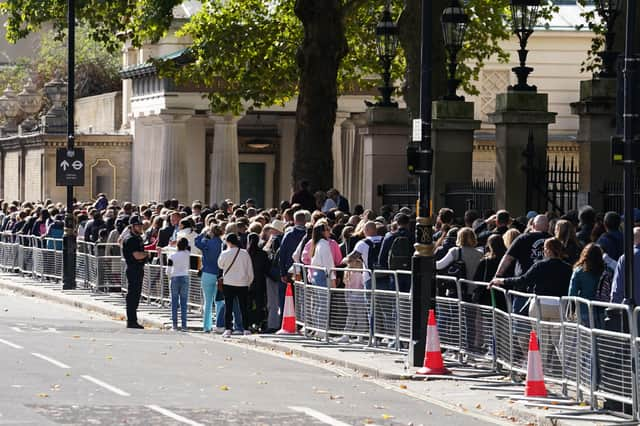Ruth Dudley Edwards: Britons turn queuing for the Queen into a pilgrimage


The weirdness of British queues became a staple of conversation all over the world for the last few days, particularly the one that snaked along the Thames and became an international phenomenon.
What were the Brits up to shuffling along for up to fourteen hours to get a one-minute look at a coffin covered by a royal standard?
Uncomplainingly. And often with apparent enjoyment.
Advertisement
Hide AdAdvertisement
Hide AdOn the radio, I heard reports of second queue forming to join the queue, and then for reasons I never understood, another being created to feed the second.
Fortunately, the British are brilliant at making fun of themselves.
One of the funniest contributions on social media was a sequence of tweets that began: ‘Tell me this isn’t the greatest bit of British performance art that has ever happened. I’m giddy with joy. It’s fantastic. We are a deeply, deeply mad people with an absolutely unshakeable need to join a queue. It’s actually glorious.’
So loud was the chord this struck that the tweets have been set to music as a Psalm: https://twitter.com/curiousiguana/status/1571188966207930369?s=20
Advertisement
Hide AdAdvertisement
Hide AdThere is no doubt that the British have a unique attitude to queues, and it reflects well on us.
None of this every-man-for-himself attitude I’ve found in other countries, including as a student in my native Dublin where only the strong could dream of getting a taxi in the free-for-all in the middle of the night.
As I got to know England, I learned that a queue-jumper was beneath contempt. A pariah.
There were simple rules.
If a queue is orderly, that’s fine.
If it’s long, it’s an adventure.
Or, in this case, a pilgrimage.
I don’t wish to disparage the other dignified queues that appeared all over the United Kingdom.
Advertisement
Hide AdAdvertisement
Hide AdPeople lined up to see the hearse, leave flowers, and, read the messages thousands had left to explain their sense of respect, admiration and loss for a woman who had been important to them all of their lives and who truly marked the end of an era.
But the huge, international London one was utterly extraordinary.
There was none of the hysteria and rage that gripped so many after the tragic death of Diana. Most people are celebrating a long life well lived. ‘I will be the best queen I can be,’ Elizabeth said, and she was.
And although there have been tears, mostly people queued to say thank you.
Advertisement
Hide AdAdvertisement
Hide AdThe immediate transition to King Charles was proceeding smoothly, and the queue was so long participants were forming relationships, helping each other, feeding each other, sharing memories and talking about the sense of a thousand-year-history conveyed by royalty and pageantry, which I’ll write about another time.
And they were communicating with family, friends and social media about their experiences.
An eighteen-year-old honorary godson invited me to join him on his trek, but much though I admired Her Majesty, I had a writing deadline and, anyway, I’d seen the spectacle before.
When the Queen Mother died 20 years ago, a kind friend with a parliamentary pass took me into Westminster Hall to pay my respects.
Advertisement
Hide AdAdvertisement
Hide AdI didn’t feel like a bad person at the time, but last week guilt was beginning to weigh on me retrospectively because of the outcry in the tabloids, phone-ins and social media about horrible, privileged people who think themselves too grand to queue for hours.
I did, however, follow Adam’s reports and buy him dinner after he emerged, and listen to stories of the people and the camaraderie that prevailed.
And then on Sunday, he decided to go again and take his mother, who reported yesterday that she had been shivering in the middle of the night but was lent a coat by a queue-buddy and had had a wonderful time.
This last ten days marking the death of Queen Elizabeth has been dominated by colour, notably in full dress uniforms with gold and silver braids, epaulettes and lampasses (I had to look that up: it’s a trouser stripe), innumerable images of a strikingly dressed, beautiful, usually smiling woman and hundreds of thousands of bouquets left outside palaces and landmarks throughout in the four nations of the United Kingdom.
Advertisement
Hide AdAdvertisement
Hide AdThe other day, I walked down Piccadilly to the 40-acre Green Park, a burial ground for lepers in the medieval period which was turned into a Royal Park by Charles II.
It has many trees but no flower beds allegedly because Charles’s Queen Consort, Catherine of Braganza, discovered he had picked flowers there for another woman and ordered the pulling up of every single flower in the park.
Valuable lessons were learned when Princess Diana was killed in 1997 and London became full of vast piles of rotting floral tributes.
This time, people wanting to leave flowers in front of Buckingham Palace are encouraged to take them instead to designated areas in Green Park much of which was now a joyous spectacle.
Advertisement
Hide AdAdvertisement
Hide AdA friend reported from on the similarly moving scenes at Hillsborough, which 20,000 people visited on Sunday and sent me this message, which spoke for all people of goodwill.
‘Dear King Charles
I am sad that your Mum has died. I hope you run the country well and with care.
Love Ellarose Kirkpatrick
Age 6.’